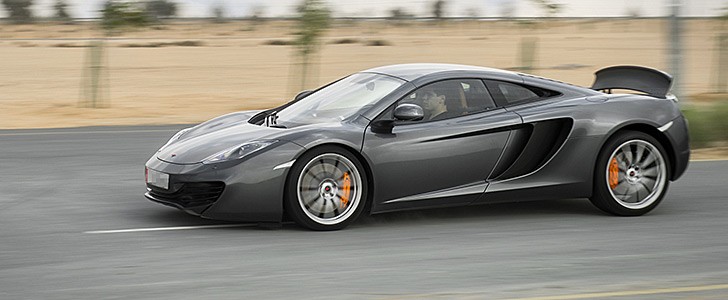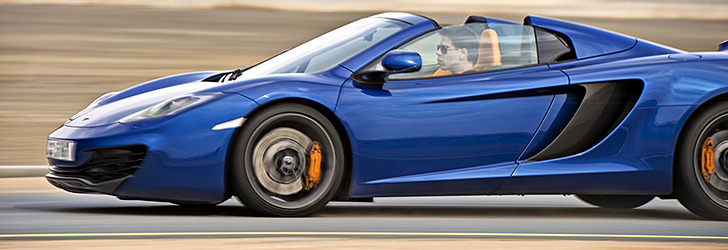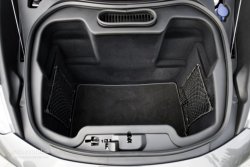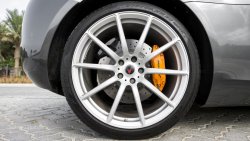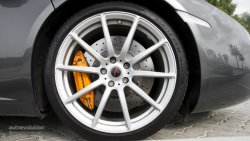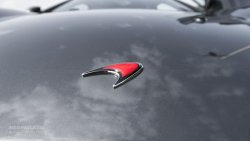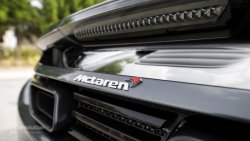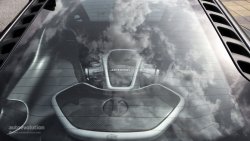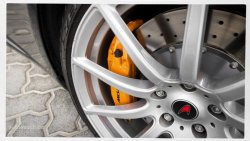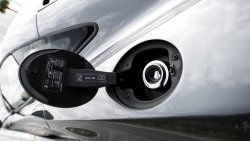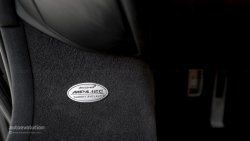MCLAREN MP4-12C Review
OUR TEST CAR: MCLAREN MP4-12C 2012
When it comes to being kind to the human beings for whom it was built, the McLaren MP4-12 provides a mixed range of feelings and emotions. The supercar possesses the technical complexity that could allow it to offer a superior level of comfort, but many of its systems simply aren't set up in a way that favors this.
The access is difficult due to the complex door opening & closing routine and the tub construction that gives the car a wide sills. When you are installed in the seats, you'll be treated with a level of comfort that sits within the class average.
Fortunately, things get better when it comes to the luggage compartment. This offers 5.09 cubic feet (144 liters) of space, one of the best values of the supercar segment. On the other hand, the MP4-12C offers a smaller overall volume than some of its competitors, due to the fact that the storage space behind the seats is virtually inexistent.
McLaren has built the MP4-12C following F1-inspired guidelines and this doesn't just help the driver, it also creates a pleasant environment. This is most obvious when talking about the "science of haptics" - many parts of the car's interior were conceived so that they also provide an useful tactile experience. This is best illustrated by the different way in which the gearbox controls buttons are sculpted and placed at a different height.
The automotive producer has also managed to pack an extremely complex vehicle function setup using a simple multi-button layout placed on the center console.
Thus, you have a three-mode switch for the powertrain and a similar one for the handling. The first also includes a manual shifting option, while the latter allows you to also deploy the rear wing. The two are activated using a dedicated button placed below, so that the passenger won't switch your handling to "track" mode by mistake.
In addition to that, we find a "winter" button and a "launch" one, but this is where the story ends. The setup is intuitive and easy to use - excellent job McLaren.
Running our fingers across the large leather-finished surfaces of our test car brought the work "OK" to mind, but nothing more. It seems that the leather upholstery is focused more on keeping the weight down rather than offering a delicate tactile experience. Fortunately, the 2013 revamp received by the car promises to offer this by allowing customers to choose from a wider range of finishes.
As for the tech bits of the MP4-12C that matter for this chapter, we'll start with the suspension. McLaren has skipped the stabilizer bars, gifting the car with a hydraulic setup that features interconnected active dampers. The ride is extremely compliant and offers an impressive separation from any road issues, but once you start to encounter more serious potholes or bumps, this doesn't shine anymore.
An element that certainly takes away points when it comes to comfort is the exhaust voice. This does feature a sound controlling valve and McLaren brags that the soundtrack was deeply tuned, but the result is rather uninspiring. The exhaust is too loud on many occasions and even if it came with fewer decibels, it would be difficult to describe its noise as "pleasant".
One of the dustiest clichés in the world of supercars is to say that a certain model is a "race car for the road". Nevertheless, the technical details of the MP4-12C demonstrate that McLaren has given us just that. Each and every technical area of the car comes with motorsport-inspired solutions that set the MP4-12C apart in the world of supercars.
Body and Chassis
The core of the McLaren MP4-12C is a carbon fiber tub called MonoCell, which reduces weight and thus increases performance in all areas. In addition to this, the carbon core of the supercar also increases rigidity, bringing benefits on both the handling and safety fronts.
McLaren pioneered carbon fiber construction in Formula one back in 1981, with the MP4/1 F1 racer, while the McLaren F1 was the first road car to use the wonder material. Carbon fiber was also featured in the Mercedes-Benz SLR McLaren.
However, the construction techniques for the aforementioned vehicles required thousands and, later on, hundreds of man-hours which pushed the costs to an astonishing level. For the MP4-12C, McLaren uses a carbon fiber composite technology, with one-piece moulding. This reduces the production process duration to just four hours.
The result of using Resin Transfer Moulding production is the hollow one-piece MonoCell, which tips the scales at just 165 lbs (75 kg). The suspension system of the vehicle is directly mounted to the carbon structure. The strong torsional rigidity of the MonoCell also means that the suspension doesn't need to use settings that make a compromise in order to deal with the flexing of the car.
The McLaren MP4-12C uses front and rear aluminum structures - the castings and extrusions are jig welded into the completed structure, being bolted to the MonoCell. The one up front is there for safety purposes, while the rear one supports the engine and the suspension. In addition to that, the windscreen frame is made of aluminum casting and features baron steel tubes for added resistance.
The supercar uses composite body panels, some of which are placed on the car using custom adhesives. Thus, the panels are both lightweight and cost-effective, but the story also has a dark side. The front fenders, bonnet and roof are built from aluminum, while most of what’s left of the MP4-12C’s body is made from glass fiber composites - Sheet Molding Compound (SMC) as McLaren calls it.
SMC is lighter than aluminum, but it doesn’t match the metal’s strict tolerance level. This means that the SMC’s perceived quality of the panels and gaps is lower than that of aluminum - McLaren has decided to trade off some of the visual effects for extra lightness.
Placing the McLaren MP4-12C and the Ferrari 458 on the scales would show a difference of about 110 lbs (50 kg) in favor of the British model - this is before ticking the lightweight option of the latter, which saves an extra 77 lbs (35 kg). As for the weight distribution of the McLaren MP4-12C, this sits at 42.5:57.5. This is 0.5 percent closer to the ideal one when compared to that of the 458 Italia.
In addition to that, McLaren claims that the MP4-12C offers a superior torsional rigidity and polar moment of inertia - the latter means that more of the mass is concentrated closer to the car’s center of gravity and has a crucial influence on the cornering turn-in.
Powertrain
McLaren's first road car, the record-breaking F1, was motivated by a V12 engine supplied by BMW. Since almost a decade separates the F1 and the MP4-12C, McLaren has now fitted the car with a downsized engine.
We are talking about the M838T, a 3,799cc V8 unit that features twin-turbocharging and dual variable valve timing. The powerplant delivers 600 hp at 7,000 rpm and a peak torque of 443 lb-ft (600 Nm), available between 3,000 and 7,000 rpm.
In addition to that, 80 percent of the aforementioned torque is delivered starting from 2,000 rpm. From the 2013 model year onwards, the unit's output has been increased to 625 hp at 7,500 rpm. This power upgrade is offered alongside a few other refinements as part of a complimentary upgrade pack for owners of the pre-update model.
Since McLaren has never built its own engines, neither for the road, nor for the track, this time it turned to British automotive supplier Ricardo for the development of the V8 unit. The powerplant also incorporates some of the lessons learned from the Nissan VRH35 endurance racing V8 unit, for which McLaren had acquired the rights to.
McLaren brags that the M838T offers the highest hp to CO2 emission ratio of all cars currently in production, including petrol, diesel and hybrid powertrains. The unit emits 279 grams of CO2 per km, compared to the 307 g/km of the Ferrari 458 Italia’s 570 hp naturally-aspirated 4.5-liter V8. Thus, it seems to be handling emissions just fine, despite not making use of direct injection.
The British V8 features dry sump lubrication and a flat plane crankshaft, which reduce its height, allowing it to be mounted low in the MP4-12C's chassis.
Like the rest of the car, the engine features weight-saving technologies, including composite cam covers and intake manifolds, as well as aluminum cylinder liners that use a Nikasil coating. With the same aim in mind, the traditional silencer box in the exhaust has been replaced with a mixing box. Up to this structure, the exhaust features sandwich layer heat shields. The result is pretty impressive, as the exhaust gas temperature is brought from 1,650 degrees Fahrenheit (900 degrees Celsius) to 1,650 degrees Fahrenheit (300 degrees Celsius) in a 0.7-inch (18 mm) area of the engine compartment.
Continuing to move along the power flow, we find a seven-speed dual wet clutch transmission coming from Graziano - the Italian supplier is a favorite child of the supercar world, which also makes the Lamborghini Aventador's ISR single-clutch automated manual, for example.
For McLaren, Gratziano has developed a Sequential Shift Gearbox (SSG) that comes with an unique feature called pre-coq. This means that the rocker used to change gears has two positions, like the trigger of a rifle. The first one can be used to tell the transmission to engage the following gear and prepare the oncoming clutch. Once the driver fully pulls the paddle, the shift takes place significantly faster than in a conventional double-clutch gearbox.
We've been used to find limited slip differentials in any high-power rear-wheel drive car that takes performance driving seriously, but the MP4-12C features an open diff. That's because McLaren decided to reduce weight by replacing the LSD with a system of its own.
The British supercar mixes the ESP with a function called Brake Steer in order to control lateral vehicle dynamics. Brake Steer draws inspiration from a similar system used on the McLaren 1997 MP4/12 Formula 1 car. The system monitors the steering angle in order to determine the line chosen by the driver and can brake the inside wheel during a corner entry, all in order to reduce understeer. Brake Steer can also be used to deal with oversteer, as the system can brake the inside rear wheel if this is spinning under corner-exit acceleration.
Road Connection
In its hate for vehicle mass, McLaren has eliminated the anti-roll bars, a feature present on any road car since as long as we can remember. To replace these, the MP4-12C uses a system called Proactive Chassis Control. This links the four adaptive dampers of the car, relying on the same pump that serves the electro-hydraulic power steering.
The system constantly adjusts the pressure in each shock absorber, based on the road conditions, as well as on the driver's preferences. The latter are read using a switch on the center console, which offers three settings: normal, sport and track.
The rest of the suspension consists of double wishbones and coil springs for both axles.
The standard cast alloy wheels come in a size of 19-inch for the front axle and 20-inch for the rear one, with McLaren bragging it has whipped engineers to cut an extra 9 lbs (4 kg) off the rims. In addition to that, McLaren has worked together with Pirelli to develop dedicated tires for the MP4-12C.
Stopping Power
The McLaren MP4-12C manages to make fun of the optional Brembo carbon-ceramic brakes it offers - the standard stopping hardware it packs is lighter than the optional ceramic one. The AP brakes of the British supercar feature forged aluminum bells, which allow them to save 18 lbs (8 kg) compared to a conventional system.
This McLaren keeps things clear in terms of vehicle configuration, so while it does have a fair level of options, these are arranged in the logical way we’d expect from a company that follows a motorsport recipe.
Thanks to the collection of technical solutions it feeds on, the MP4-12C proves superior to many contemporary supercars from this point of view. Alas, McLaren hasn’t used the same high-tech approach in terms of features, an area where the car plays within the limits of the segment.
Let’s take the exterior lighting setup, for example. The taillights use an intelligent all-LED setup, which, among others, incorporates a lamp that can serve both as a fog and as a reverse unit. However, up front we only get LED technology for the daytime running lights.
The 2013 model year has seen McLaren update the MP4-12C, with the company following customer feedback and introducing multiple features aimed at making the car more pleasant to use, along with a power increase.
The standard setup allows you to choose between three colors: white, silver and blue and these are mixed with a satin dark grey finish for the front splitter and rear diffuser.
Climbing aboard, we find manual seats with a part leather finish, as well as a manually-adjustable steering column and non-active cruise control. You also get dual-zone climate control, an electric park brake, as well as keyless entry and start.
In terms of infotainment, the McLaren MP4-12C offers a 7-inch touch screen display that features a portrait setup. This can be used to control the audio system, a four-speaker Meridian development.
Once you’ll start adding optional extras, you’ll be able to choose from a much wider range of exterior shades, split between the Special and the Elite categories. The brake calipers can also receive special attention and you’ll be able to choose between multiple wheel designs and finishes.
The splitter and diffuser can be finished to match the body or to create a contrast. There’s also a comprehensive carbon fiber treatment, which can include separate parts, such as the two aforementioned ones, mirror casings, side air intakes, engine cover and engine compartment.
The tech improvements include an Inconel sports exhaust system and, more importantly parking sensors and a lift system.
We have to explain that you can shave about 77 lbs (35 kg) of the McLaren MP4-12C if you opt for the lightweight pack. This includes the aforementioned carbon fiber splitter and diffuser, Inconel exhaust, Brembo ceramic brakes, Recaro carbon fiber seats, even lighter wheels and Pirelli P Zero Corsa rubber.
There’s also a vehicle lift system. This raises the car by around 1.5 inches (40 mm) up front and about 1 inch (25 mm) at the rear, operating up to a speed of 37 mph (60 km/h). In addition to that, we have the tire pressuring monitoring system.
The optional features for the cabin allow you to choose between materials such as leather, “sport” leather and Alcantara - you can also select separate finishes for certain areas of the interior. If you choose the electric and heated seats, you’ll also be able to opt for a Semi-Aniline leather interior.
Carbon fiber is, of course, present and can be used on the dashboard and door entry sills. The most eccentric of you can also have the wonder material on the seat backs and wheel arches.
In the twenty-first century, a supercar buyer has to be able to do things like walking in the showroom and asking for a headliner that matches his t-shirt - to handle this, the British carmaker uses the McLaren Special Operations divisions.
These people take themselves very seriously and to showcase their capabilities they’ve built the X1, a one-off project based on the MP4-12C. The styling of the X1 may not please every beholder - we’re not to thrilled ourselves - but the project clearly shows a stunning level of attention to details and customization potential.
Be it passive or active safety, the McLaren MP4-12C has a meticulous way of offering protection to its occupants. It all starts at the core of the car, its carbon fiber tub, which provides an incredibly strong passenger cell.
In the event of a frontal impact, the tub is assisted by the aluminum safety structures that make up the crumple zones in front of it. When it comes to side impact protection, the same carbon fiber tub offers the MP4-12C a generous structure to absorb the force of a potential crash.
As for the airbags, this McLaren offers two frontal ones and two side head units. We’ll also mention the fact that the doors offer both an exterior and an interior secondary mechanical release mechanism.
In terms of active safety, we have to tell you that this is one of the most difficult rear-wheel drive supercars to be placed in a “driver lost control” sentence. That’s because the McLaren MP4-12C makes a religion out of assisting the driver in keeping the vehicle on track.
First of all, it uses electronic control for each rear wheel instead of a limited-slip differential, so any wheelspin that could result in oversteer is instantly killed. It reinforces this by featuring Brake Steer, which applies braking pressure on the rear wheels when this spin out of control.
Even when it comes to braking the McLaren MP4-12C has an ace up its fender, in the form of its Airbrake. This doesn’t only reduce deceleration times, but it shifts the pressure center of the car towards the back - braking normally sends this towards the front of the car. This makes the conventional braking system of the car more effective by boosting the downforce and yaw stability.
We can say that when driving the McLaren MP4-12C, the safety team is always traveling on board the vehicle.
Last time we saw McLaren in action on the road, it had joined forces with Mercedes-Benz, with the two giving the world the brilliant, but limited volume SLR. The companies have parted ways, with Mercedes driving down a more emotional road and giving us the SLS AMG - not the fastest supercar on sale, but definitely one of the most delightful to drive.
McLaren on the other hand has stuck to its all-performance, racing-derived philosophy and has now returned to the market with the MP4-12C. This time the British company wanted to actually sell cars, so it didn’t just create one - it also built a production facility, upgraded it and established a worldwide dealer network.
So the determination is here. The technical expertise is also here, brought straight from the F1 laboratories. Then again, McLaren has always possessed this asset, but now they’ve used in a way that would make the car available to a broader audience. For example, the MP4-12C is the first model in the mainstream supercar segment to offer a carbon fiber construction.
In fact, the technical innovations of the McLaren MP4-12C make up the best part of the car. The British model does away with conventional solutions and has its way when it comes to generating g forces.
McLaren has managed to adapt as much as possible of an F1 car for the road and place it within the confinements of a $241,800 MSRP, which is quite an achievement. We have to remind you that there’s also a destination charge of $2,400 and that the European pricing sits at EUR200,000 (including 19 percent VAT).
And the champagne brought by the aforementioned title has to be shared with the performance. This McLaren comes with a power-to-weight ratio that makes it disappear into the horizon when the driver wishes for this to happen. Straight lines or bends, the MP4-12C devours the tarmac at an astonishing pace.
Alas, the F1-style hardware incorporated into this McLaren means that if you really want to push it to the limit, you’ll have to adapt to the car’s handling ways, not the other way around.
And while this is an aspect that you can live with, the same can’t be said about the MP4-12C’s greatest problem, it’s clinical character. When you’re hammering this McLaren, it teleports you straight to insanity land and it literally spits fire. Unfortunately, the moment your foot leaves the throttle, the magic fades away. In this respect (only), the McLaren MP4-12C feels similar to the Nissan GT-R.
And then there’s the exhaust - this is a perfect example of tech genius, but it fails to impress on the emotional level and its volume even becomes disturbing at times.
What McLaren needs is somebody that can blow some magic emotional dust over its factory. Yes, it can outperform its target, the Ferrari 458, but only on paper. Until the Woking building will also employ a wand, the MP4-12C has no chance of being a better car than the 458.
This McLaren is a brilliant piece of engineering, also being easy to drive, but since it misses the melodramatic part of the supercar concept, it’s still not targeting a full-size audience.
The access is difficult due to the complex door opening & closing routine and the tub construction that gives the car a wide sills. When you are installed in the seats, you'll be treated with a level of comfort that sits within the class average.
Fortunately, things get better when it comes to the luggage compartment. This offers 5.09 cubic feet (144 liters) of space, one of the best values of the supercar segment. On the other hand, the MP4-12C offers a smaller overall volume than some of its competitors, due to the fact that the storage space behind the seats is virtually inexistent.
McLaren has built the MP4-12C following F1-inspired guidelines and this doesn't just help the driver, it also creates a pleasant environment. This is most obvious when talking about the "science of haptics" - many parts of the car's interior were conceived so that they also provide an useful tactile experience. This is best illustrated by the different way in which the gearbox controls buttons are sculpted and placed at a different height.
The automotive producer has also managed to pack an extremely complex vehicle function setup using a simple multi-button layout placed on the center console.
Thus, you have a three-mode switch for the powertrain and a similar one for the handling. The first also includes a manual shifting option, while the latter allows you to also deploy the rear wing. The two are activated using a dedicated button placed below, so that the passenger won't switch your handling to "track" mode by mistake.
In addition to that, we find a "winter" button and a "launch" one, but this is where the story ends. The setup is intuitive and easy to use - excellent job McLaren.
Running our fingers across the large leather-finished surfaces of our test car brought the work "OK" to mind, but nothing more. It seems that the leather upholstery is focused more on keeping the weight down rather than offering a delicate tactile experience. Fortunately, the 2013 revamp received by the car promises to offer this by allowing customers to choose from a wider range of finishes.
As for the tech bits of the MP4-12C that matter for this chapter, we'll start with the suspension. McLaren has skipped the stabilizer bars, gifting the car with a hydraulic setup that features interconnected active dampers. The ride is extremely compliant and offers an impressive separation from any road issues, but once you start to encounter more serious potholes or bumps, this doesn't shine anymore.
An element that certainly takes away points when it comes to comfort is the exhaust voice. This does feature a sound controlling valve and McLaren brags that the soundtrack was deeply tuned, but the result is rather uninspiring. The exhaust is too loud on many occasions and even if it came with fewer decibels, it would be difficult to describe its noise as "pleasant".
One of the dustiest clichés in the world of supercars is to say that a certain model is a "race car for the road". Nevertheless, the technical details of the MP4-12C demonstrate that McLaren has given us just that. Each and every technical area of the car comes with motorsport-inspired solutions that set the MP4-12C apart in the world of supercars.
Body and Chassis
The core of the McLaren MP4-12C is a carbon fiber tub called MonoCell, which reduces weight and thus increases performance in all areas. In addition to this, the carbon core of the supercar also increases rigidity, bringing benefits on both the handling and safety fronts.
McLaren pioneered carbon fiber construction in Formula one back in 1981, with the MP4/1 F1 racer, while the McLaren F1 was the first road car to use the wonder material. Carbon fiber was also featured in the Mercedes-Benz SLR McLaren.
However, the construction techniques for the aforementioned vehicles required thousands and, later on, hundreds of man-hours which pushed the costs to an astonishing level. For the MP4-12C, McLaren uses a carbon fiber composite technology, with one-piece moulding. This reduces the production process duration to just four hours.
The result of using Resin Transfer Moulding production is the hollow one-piece MonoCell, which tips the scales at just 165 lbs (75 kg). The suspension system of the vehicle is directly mounted to the carbon structure. The strong torsional rigidity of the MonoCell also means that the suspension doesn't need to use settings that make a compromise in order to deal with the flexing of the car.
The McLaren MP4-12C uses front and rear aluminum structures - the castings and extrusions are jig welded into the completed structure, being bolted to the MonoCell. The one up front is there for safety purposes, while the rear one supports the engine and the suspension. In addition to that, the windscreen frame is made of aluminum casting and features baron steel tubes for added resistance.
The supercar uses composite body panels, some of which are placed on the car using custom adhesives. Thus, the panels are both lightweight and cost-effective, but the story also has a dark side. The front fenders, bonnet and roof are built from aluminum, while most of what’s left of the MP4-12C’s body is made from glass fiber composites - Sheet Molding Compound (SMC) as McLaren calls it.
SMC is lighter than aluminum, but it doesn’t match the metal’s strict tolerance level. This means that the SMC’s perceived quality of the panels and gaps is lower than that of aluminum - McLaren has decided to trade off some of the visual effects for extra lightness.
Placing the McLaren MP4-12C and the Ferrari 458 on the scales would show a difference of about 110 lbs (50 kg) in favor of the British model - this is before ticking the lightweight option of the latter, which saves an extra 77 lbs (35 kg). As for the weight distribution of the McLaren MP4-12C, this sits at 42.5:57.5. This is 0.5 percent closer to the ideal one when compared to that of the 458 Italia.
In addition to that, McLaren claims that the MP4-12C offers a superior torsional rigidity and polar moment of inertia - the latter means that more of the mass is concentrated closer to the car’s center of gravity and has a crucial influence on the cornering turn-in.
Powertrain
McLaren's first road car, the record-breaking F1, was motivated by a V12 engine supplied by BMW. Since almost a decade separates the F1 and the MP4-12C, McLaren has now fitted the car with a downsized engine.
We are talking about the M838T, a 3,799cc V8 unit that features twin-turbocharging and dual variable valve timing. The powerplant delivers 600 hp at 7,000 rpm and a peak torque of 443 lb-ft (600 Nm), available between 3,000 and 7,000 rpm.
In addition to that, 80 percent of the aforementioned torque is delivered starting from 2,000 rpm. From the 2013 model year onwards, the unit's output has been increased to 625 hp at 7,500 rpm. This power upgrade is offered alongside a few other refinements as part of a complimentary upgrade pack for owners of the pre-update model.
Since McLaren has never built its own engines, neither for the road, nor for the track, this time it turned to British automotive supplier Ricardo for the development of the V8 unit. The powerplant also incorporates some of the lessons learned from the Nissan VRH35 endurance racing V8 unit, for which McLaren had acquired the rights to.
McLaren brags that the M838T offers the highest hp to CO2 emission ratio of all cars currently in production, including petrol, diesel and hybrid powertrains. The unit emits 279 grams of CO2 per km, compared to the 307 g/km of the Ferrari 458 Italia’s 570 hp naturally-aspirated 4.5-liter V8. Thus, it seems to be handling emissions just fine, despite not making use of direct injection.
The British V8 features dry sump lubrication and a flat plane crankshaft, which reduce its height, allowing it to be mounted low in the MP4-12C's chassis.
Like the rest of the car, the engine features weight-saving technologies, including composite cam covers and intake manifolds, as well as aluminum cylinder liners that use a Nikasil coating. With the same aim in mind, the traditional silencer box in the exhaust has been replaced with a mixing box. Up to this structure, the exhaust features sandwich layer heat shields. The result is pretty impressive, as the exhaust gas temperature is brought from 1,650 degrees Fahrenheit (900 degrees Celsius) to 1,650 degrees Fahrenheit (300 degrees Celsius) in a 0.7-inch (18 mm) area of the engine compartment.
Continuing to move along the power flow, we find a seven-speed dual wet clutch transmission coming from Graziano - the Italian supplier is a favorite child of the supercar world, which also makes the Lamborghini Aventador's ISR single-clutch automated manual, for example.
For McLaren, Gratziano has developed a Sequential Shift Gearbox (SSG) that comes with an unique feature called pre-coq. This means that the rocker used to change gears has two positions, like the trigger of a rifle. The first one can be used to tell the transmission to engage the following gear and prepare the oncoming clutch. Once the driver fully pulls the paddle, the shift takes place significantly faster than in a conventional double-clutch gearbox.
We've been used to find limited slip differentials in any high-power rear-wheel drive car that takes performance driving seriously, but the MP4-12C features an open diff. That's because McLaren decided to reduce weight by replacing the LSD with a system of its own.
The British supercar mixes the ESP with a function called Brake Steer in order to control lateral vehicle dynamics. Brake Steer draws inspiration from a similar system used on the McLaren 1997 MP4/12 Formula 1 car. The system monitors the steering angle in order to determine the line chosen by the driver and can brake the inside wheel during a corner entry, all in order to reduce understeer. Brake Steer can also be used to deal with oversteer, as the system can brake the inside rear wheel if this is spinning under corner-exit acceleration.
Road Connection
In its hate for vehicle mass, McLaren has eliminated the anti-roll bars, a feature present on any road car since as long as we can remember. To replace these, the MP4-12C uses a system called Proactive Chassis Control. This links the four adaptive dampers of the car, relying on the same pump that serves the electro-hydraulic power steering.
The system constantly adjusts the pressure in each shock absorber, based on the road conditions, as well as on the driver's preferences. The latter are read using a switch on the center console, which offers three settings: normal, sport and track.
The rest of the suspension consists of double wishbones and coil springs for both axles.
The standard cast alloy wheels come in a size of 19-inch for the front axle and 20-inch for the rear one, with McLaren bragging it has whipped engineers to cut an extra 9 lbs (4 kg) off the rims. In addition to that, McLaren has worked together with Pirelli to develop dedicated tires for the MP4-12C.
Stopping Power
The McLaren MP4-12C manages to make fun of the optional Brembo carbon-ceramic brakes it offers - the standard stopping hardware it packs is lighter than the optional ceramic one. The AP brakes of the British supercar feature forged aluminum bells, which allow them to save 18 lbs (8 kg) compared to a conventional system.
This McLaren keeps things clear in terms of vehicle configuration, so while it does have a fair level of options, these are arranged in the logical way we’d expect from a company that follows a motorsport recipe.
Thanks to the collection of technical solutions it feeds on, the MP4-12C proves superior to many contemporary supercars from this point of view. Alas, McLaren hasn’t used the same high-tech approach in terms of features, an area where the car plays within the limits of the segment.
Let’s take the exterior lighting setup, for example. The taillights use an intelligent all-LED setup, which, among others, incorporates a lamp that can serve both as a fog and as a reverse unit. However, up front we only get LED technology for the daytime running lights.
The 2013 model year has seen McLaren update the MP4-12C, with the company following customer feedback and introducing multiple features aimed at making the car more pleasant to use, along with a power increase.
The standard setup allows you to choose between three colors: white, silver and blue and these are mixed with a satin dark grey finish for the front splitter and rear diffuser.
Climbing aboard, we find manual seats with a part leather finish, as well as a manually-adjustable steering column and non-active cruise control. You also get dual-zone climate control, an electric park brake, as well as keyless entry and start.
In terms of infotainment, the McLaren MP4-12C offers a 7-inch touch screen display that features a portrait setup. This can be used to control the audio system, a four-speaker Meridian development.
Once you’ll start adding optional extras, you’ll be able to choose from a much wider range of exterior shades, split between the Special and the Elite categories. The brake calipers can also receive special attention and you’ll be able to choose between multiple wheel designs and finishes.
The splitter and diffuser can be finished to match the body or to create a contrast. There’s also a comprehensive carbon fiber treatment, which can include separate parts, such as the two aforementioned ones, mirror casings, side air intakes, engine cover and engine compartment.
The tech improvements include an Inconel sports exhaust system and, more importantly parking sensors and a lift system.
We have to explain that you can shave about 77 lbs (35 kg) of the McLaren MP4-12C if you opt for the lightweight pack. This includes the aforementioned carbon fiber splitter and diffuser, Inconel exhaust, Brembo ceramic brakes, Recaro carbon fiber seats, even lighter wheels and Pirelli P Zero Corsa rubber.
There’s also a vehicle lift system. This raises the car by around 1.5 inches (40 mm) up front and about 1 inch (25 mm) at the rear, operating up to a speed of 37 mph (60 km/h). In addition to that, we have the tire pressuring monitoring system.
The optional features for the cabin allow you to choose between materials such as leather, “sport” leather and Alcantara - you can also select separate finishes for certain areas of the interior. If you choose the electric and heated seats, you’ll also be able to opt for a Semi-Aniline leather interior.
Carbon fiber is, of course, present and can be used on the dashboard and door entry sills. The most eccentric of you can also have the wonder material on the seat backs and wheel arches.
In the twenty-first century, a supercar buyer has to be able to do things like walking in the showroom and asking for a headliner that matches his t-shirt - to handle this, the British carmaker uses the McLaren Special Operations divisions.
These people take themselves very seriously and to showcase their capabilities they’ve built the X1, a one-off project based on the MP4-12C. The styling of the X1 may not please every beholder - we’re not to thrilled ourselves - but the project clearly shows a stunning level of attention to details and customization potential.
Be it passive or active safety, the McLaren MP4-12C has a meticulous way of offering protection to its occupants. It all starts at the core of the car, its carbon fiber tub, which provides an incredibly strong passenger cell.
In the event of a frontal impact, the tub is assisted by the aluminum safety structures that make up the crumple zones in front of it. When it comes to side impact protection, the same carbon fiber tub offers the MP4-12C a generous structure to absorb the force of a potential crash.
As for the airbags, this McLaren offers two frontal ones and two side head units. We’ll also mention the fact that the doors offer both an exterior and an interior secondary mechanical release mechanism.
In terms of active safety, we have to tell you that this is one of the most difficult rear-wheel drive supercars to be placed in a “driver lost control” sentence. That’s because the McLaren MP4-12C makes a religion out of assisting the driver in keeping the vehicle on track.
First of all, it uses electronic control for each rear wheel instead of a limited-slip differential, so any wheelspin that could result in oversteer is instantly killed. It reinforces this by featuring Brake Steer, which applies braking pressure on the rear wheels when this spin out of control.
Even when it comes to braking the McLaren MP4-12C has an ace up its fender, in the form of its Airbrake. This doesn’t only reduce deceleration times, but it shifts the pressure center of the car towards the back - braking normally sends this towards the front of the car. This makes the conventional braking system of the car more effective by boosting the downforce and yaw stability.
We can say that when driving the McLaren MP4-12C, the safety team is always traveling on board the vehicle.
Last time we saw McLaren in action on the road, it had joined forces with Mercedes-Benz, with the two giving the world the brilliant, but limited volume SLR. The companies have parted ways, with Mercedes driving down a more emotional road and giving us the SLS AMG - not the fastest supercar on sale, but definitely one of the most delightful to drive.
McLaren on the other hand has stuck to its all-performance, racing-derived philosophy and has now returned to the market with the MP4-12C. This time the British company wanted to actually sell cars, so it didn’t just create one - it also built a production facility, upgraded it and established a worldwide dealer network.
So the determination is here. The technical expertise is also here, brought straight from the F1 laboratories. Then again, McLaren has always possessed this asset, but now they’ve used in a way that would make the car available to a broader audience. For example, the MP4-12C is the first model in the mainstream supercar segment to offer a carbon fiber construction.
In fact, the technical innovations of the McLaren MP4-12C make up the best part of the car. The British model does away with conventional solutions and has its way when it comes to generating g forces.
McLaren has managed to adapt as much as possible of an F1 car for the road and place it within the confinements of a $241,800 MSRP, which is quite an achievement. We have to remind you that there’s also a destination charge of $2,400 and that the European pricing sits at EUR200,000 (including 19 percent VAT).
And the champagne brought by the aforementioned title has to be shared with the performance. This McLaren comes with a power-to-weight ratio that makes it disappear into the horizon when the driver wishes for this to happen. Straight lines or bends, the MP4-12C devours the tarmac at an astonishing pace.
Alas, the F1-style hardware incorporated into this McLaren means that if you really want to push it to the limit, you’ll have to adapt to the car’s handling ways, not the other way around.
And while this is an aspect that you can live with, the same can’t be said about the MP4-12C’s greatest problem, it’s clinical character. When you’re hammering this McLaren, it teleports you straight to insanity land and it literally spits fire. Unfortunately, the moment your foot leaves the throttle, the magic fades away. In this respect (only), the McLaren MP4-12C feels similar to the Nissan GT-R.
And then there’s the exhaust - this is a perfect example of tech genius, but it fails to impress on the emotional level and its volume even becomes disturbing at times.
What McLaren needs is somebody that can blow some magic emotional dust over its factory. Yes, it can outperform its target, the Ferrari 458, but only on paper. Until the Woking building will also employ a wand, the MP4-12C has no chance of being a better car than the 458.
This McLaren is a brilliant piece of engineering, also being easy to drive, but since it misses the melodramatic part of the supercar concept, it’s still not targeting a full-size audience.
THE END
12
Our MCLAREN Testdrives:
Photo gallery (74)
